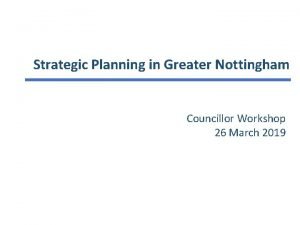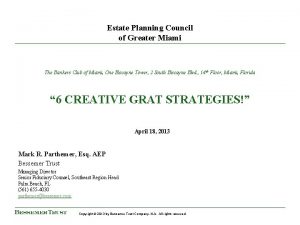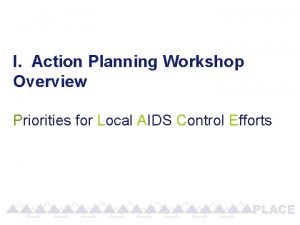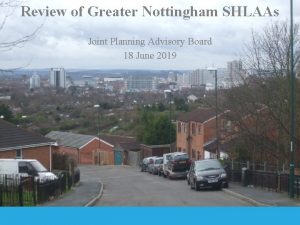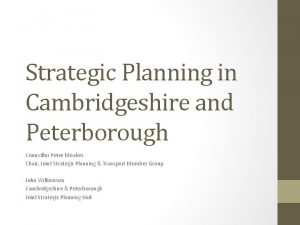Strategic Planning in Greater Nottingham Councillor Workshop 26

















- Slides: 17

Strategic Planning in Greater Nottingham Councillor Workshop 26 March 2019

Our objectives for today are…. To start thinking about the key issues affecting Greater Nottingham’s growth over the next 20 -30 years and what this means specifically for joint working/planning amongst the local authority partners.

Our Agenda for today is… 1. Welcome and Introductions 2. The national picture and practice from elsewhere 3. Discussion session 1 What are the key strategic influences on growth in Greater Nottingham in the next 20 -30 years (opportunities & threats)? 4. Discussion session 2 What will be needed (strategic interventions) to make the most of Greater Nottingham’s potential and deliver ‘good growth’, enhancing the overall ‘place value’? What will be the main challenges? 5. Next steps?

The national picture 2019

The journey back to effective strategic planning 2016 2017 Government Technical Consultation highlights “the advantages of strong strategic plan-making across local planning authority boundaries, in particular in addressing housing need across housing market areas”. Local Plan Expert Group identifies challenges around strategic planning as key barrier to local plan preparation and growth and recommends changes to provide ‘more teeth’ to the Duty to Cooperate, most of which have subsequently been taken forward by Government set out initial proposals for planning reform in Housing White Paper - new ‘strategic’ local plan option preferably with “…more and more local authorities working together to produce a strategic plan over a wider area on the functional economic geography that is right for their part of the world. . . ”; more robust approach to be introduced to Duty to Cooperate through mandatory ‘statements of common ground’ (to include county councils) and new examination ‘tests of soundness’. Further details set out in the later Right Homes in Right Places consultation. Neighbourhood Planning Act 2017 provides statutory requirement to set out ‘strategic priorities’ through planning ‘portfolio’, more LP intervention powers and new powers to allow the Secretary of State to direct the preparation of a joint local plan where this would “facilitate the more effective planning of the development and use of land in the area”. Joint working over strategic areas key criterion on Government decisions on Housing Infrastructure Fund and Planning Delivery Fund aimed at supporting “greater collaboration between councils, a more strategic approach to planning, housing and infrastructure…” So. S LP intervention process initiated for first 15 LPAs- So. S decisions to be “informed by the wider planning context in each area (specifically the extent to which authorities are working cooperatively to put strategic plans in place)”. 2018 Need for more effective strategic and infrastructure planning emphasised in wider Government announcements with Budget 2017 endorsing Cam-MK-Ox Corridor and proposals for new ‘strategic infrastructure tariff’ (SIT) and 5 new towns in South East; and Industrial Strategy White Paper emphasising support for “greater collaboration between councils, a more strategic approach to planning housing and infrastructure…” First new style Joint Strategic Plan submitted for examination (West of England) with four others being prepared. Other LAs considering a move to the new strategic plans on joint basis. Revised NPPF published July 2018 confirming support for joint plans and development plan ‘portfolio’

Strategic Planning 2019 "Our general thrust is for groups of local authorities to come together to form a kind of strategic partnership and vision for a particular region or area, fundamentally so that we can fund the infrastructure that's related to it. ” "We are unable to put the infrastructure that's required through the [Housing Infrastructure Fund] against proposals unless they have that kind of pan-regional or cross-area coordination. " Kit Malthouse, Minister for Housing

Strategic planning 2019 Overall Government priority: increase housing delivery to 300 k per annum Quicker and more effective plan-making Speed up delivery of local plans (e. g. intervention, use of planning ‘freedoms & flexibilities’, HDT, standard methodology) More effective strategic planning • New local plan ‘portfolio’ approach introduced with emphasis on joint planning • Duty to Cooperate strengthened through Statement of Common Ground and new tests of soundness to ensure Dt. C is ‘duty to agree’- Strategic policies to be “informed by agreements with other authorities” and “based on effective joint working on cross-boundary strategic matters that have been dealt with rather than deferred, as evidenced by the statement of common ground”. • Strategic Infrastructure Tariff to be introduced - but can only be levied by combined authorities or through statutory joint local plan committee (as currently proposed). • Increasing number of housing and growth deals with more effective joint planning a key part. • Fiscal incentives offered for more effective strategic planning through government infrastructure & capacity funding. • Strategic planning key factor in government agency priorities e. g. Highways/ Homes England. • Strategic approach to transport beginning to emerge through Sub-national transport bodies • Strong influence beginning to emerge from Local Industrial Strategies that will set out 20 year strategies, including some spatial priorities • National spatial priorities begin to emerge from Government e. g. CAMKOX Corridor, Thames Estuary, Northern Powerhouse, new towns (in South East)

Strategic planning 2019 Statutory Joint Strategic Plans (Statutory) 1. 2. 3. 4. 5. Greater Exeter Strategic Plan* Oxfordshire Joint Strategic Spatial Plan* South Essex Joint Strategic Plan* South West Herts Joint Strategic Plan* West of England Joint Spatial Plan* Spatial Development Strategies (Statutory)** 6. 7. 8. 20 Statutory Joint LPs and Joint/Aligned Strategies 6 7 . . 13 18 9 17 14 24 23 19 16 . 22 21 2 5 . 4 . 30 26 1 10 . 25 29 . 8 15 . 12 28 11 Greater Manchester Spatial Framework* Liverpool City Region Spatial Development Strategy* The London Plan 3 . 27 9. 10. 11. 12. 13. 14. 15. 16. 17. 18. 19. 20. 21. Greater Derby Aligned Core Strategies Plymouth and SW Devon Joint Local Plan* North Devon & Torridge Joint Local Plan* North Essex Aligned Strategies* Central Lincolnshire Joint Local plan South East Lincolnshire Joint Local Plan Greater Norwich Joint Local Plan Northants Joint Core Strategy Greater Nottingham Aligned Core Strategies Newcastle Upon Lyme & Stoke Joint Local Plan* Black Country Joint Core Strategy Central Lancashire Joint Local Plan* Gloucester, Tewksbury & Cheltenham Joint Core Strategy Non-Statutory Strategic planning and/ or Growth Frameworks 22. 23. 24. 25. 26. 27. 28. 29. 30. Cambridge & Peterborough CA Spatial Framework* Leicester & Leicestershire Strategic Growth Plan Norfolk Strategic Planning Framework PUSH Spatial Position Statement Somerset Growth Plan Suffolk Strategic Planning & Infrastructure Framework Surrey Local Strategic Statement (Interim) West Sussex & Greater Brighton Local Strategic Statement Heathrow Strategic Planning Framework* *Emerging plans/ frameworks ** subject to their own defined legislation & Regulations i. e. not development plan documents

Joint Strategic Plans 2019 Five groups of authorities preparing new style Joint Strategic Plans: Greater Exeter, Oxfordshire, South Essex, South West Herts, West of England Long term (2050) strategic investment strategies with statutory status being prepared within clear growth narrative & strategy Focused scope with small number of strategic policies and no site allocations Larger areas covered than traditional LPs with ‘boundary-off’ approach focusing on ‘place’ and not numbers All are S 28 joint plans but with no joint decision-making (S 29 committee) therefore decisions made by individual LPAs. Main drivers - planning on bigger spatial canvas, access to funding and stronger place leadership. Cost approx. £ 2 -3 m but significant potential savings due to shared evidence base, skills and capacity West of England JSP first to be examined with Hearings starting in May.

Aligning strategic ambitions and priorities The role of Local Industrial Strategies • Local industrial strategies to be prepared by mayoral/ combined authorities or LEPs – initial round to be agreed by March 2019, the rest March 2020 • Focus on rebalancing Britain with investment in transport managed through CAs and sub-national transport bodies • 20 year plans with sectorial and spatial priorities • Strong emphasis on infrastructure priorities and on clean growth – clear links with 25 Year Environment Plan (including role of natural capital) • NPPF now requires LIS to be taken into account in plan-making “We want to support greater collaboration between councils, a more strategic approach to planning housing and infrastructure, more innovation and high quality design in new homes and creating the right conditions for new private investment. ” The role of Sub-national Transport Bodies (STBs) • Focus of single conversation around strategic transport priorities and investment to help deliver improved collective transport planning and decision making over areas larger than current transport authorities • Will eventually be statutory bodies with significant funding potential and key role in influencing spatial priorities • Develop integrated transport strategies and plans for their areas. • Strong focus on supporting growth – investment to be directed where can achieve ‘biggest bang for your buck’

Strategic collaboration– some of the key issues • Place-based v housing numbers - Move away from ‘planning by numbers’ to place-based approach but housing numbers still main measurement of success by Government (Treasury!). • Place Narrative– clearly articulated narrative around long term growth potential of a place, including what the USP is, and strategic investment priorities are essential for competitive funding processes (whether via government or LEPs/STBs) –must go beyond spatial planning. • Strategic geography - Many LAs still looking for perfect strategic planning geography when it often needs to be managed at different spatial levels (e. g. city-region-LEP-STB). • Place leadership – Key driver is stronger collective leadership to influence priorities of others and access funding but sensitivities around shared governance remain in many parts of the country, particularly in two-tier areas – LGR also beginning to impact. • Alignment in strategic investment priorities – Alignment (vertical and horizontal) between spatial, economic and infrastructure priorities still too fragmented – increasing number of bodies involved in ‘place agenda’ (e. g. LEPs, STBs, NIC, Government). • Statutory v non-statutory – As with strategic governance, approach will depend on what you want to get out of the process e. g. statutory JSP a prerequisite for Oxfordshire style housing and growth deal • Skills and capacity – Need to rethink what is needed in terms of skills and expertise (e. g. partnership, negotiation, strategic planning, delivery skills) and access these in different ways (e. g. South Essex ‘co-located’ team). Need to reinvent strategic planning ‘ringmaster’ role!

Workshop Session

Developing a new Place Ambition for Greater Nottingham – some things to think about • What is the overall appetite for growth amongst partners and how will this be articulated? • What is the area’s USP – what makes it different to other places and therefore worth investing e. g. compared to other areas within Midlands Connect or D 2 N 2 LEP (or nationally)? • What does long term growth look like in Greater Nottingham when looked at through strategic lens rather than on individual LA basis (i. e. boundary-off approach)? • What are the key issues that will need to be addressed on a shared basis? E. g. • The future role of town centres (and urban areas generally) • Enhancing connectivity (transport and digital) • Delivering ‘good’ growth (e. g. role of natural capital/ green infrastructure in health and well-being, ensuring high quality place-making/ design, delivering diversity in housing to meet different needs, meeting the needs of ageing population) • What type of land premises will be needed to support local industrial priorities • Will this need a different approach to plan-making (i. e. move from aligned strategies to joint strategic plan)? • What is the timescale, taking into account need to influence decisions of LEP (LIS) and Midlands Connect Transport Strategy, next round of local plans? • What resources and skills will be needed?

Workshop Session 1 What are the key strategic influences on growth in Greater Nottingham in the next 20 -30 years (opportunities & threats)?

Workshop Session 2 What will be needed (strategic interventions) to make the most of Greater Nottingham’s potential and deliver ‘good growth’, enhancing the overall ‘place value’? What will be the main challenges?

Next steps… 1. Do you have some clear actions to take this forward? 2. Who will be responsible for the actions? 2. How will others be engaged e. g. Leaders, CXs? 3. Timescale?

Tel: +44 7710405957 Email: catrionariddell@btinternet. com Twitter: @Catriona. Riddel 1
 Strategic planning workshop greater manchester
Strategic planning workshop greater manchester Strategic planning workshop exercises
Strategic planning workshop exercises Strategic planning vs tactical planning
Strategic planning vs tactical planning Bankers club miami
Bankers club miami Visual strategic planning
Visual strategic planning Action planning workshop
Action planning workshop Action planning workshop
Action planning workshop Strategic fit vs strategic intent
Strategic fit vs strategic intent Strategic complements and substitutes examples
Strategic complements and substitutes examples Strategic management and strategic competitiveness
Strategic management and strategic competitiveness Analysing the 6 strategic options megxit
Analysing the 6 strategic options megxit Bemh nottingham
Bemh nottingham Whitchester house
Whitchester house Pebblepad nottingham
Pebblepad nottingham Jimmy huang nottingham
Jimmy huang nottingham Dsl nottingham
Dsl nottingham Employee engagement nottingham
Employee engagement nottingham Bemh nottingham
Bemh nottingham
